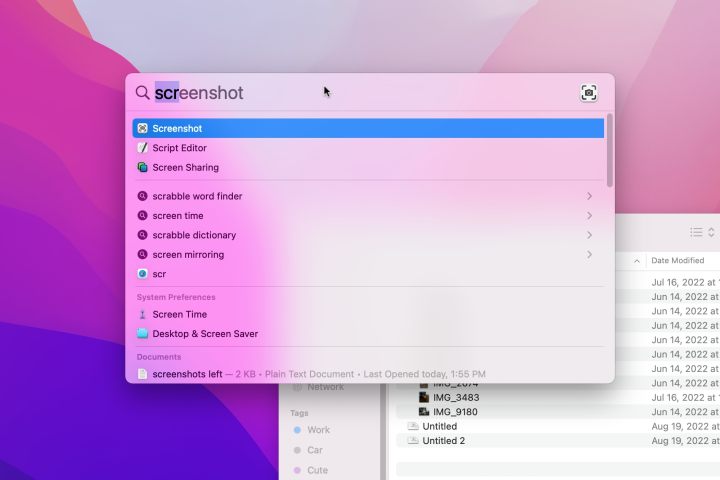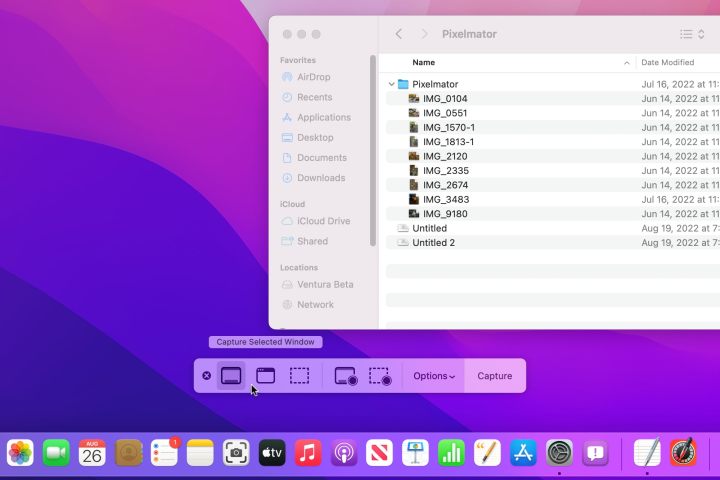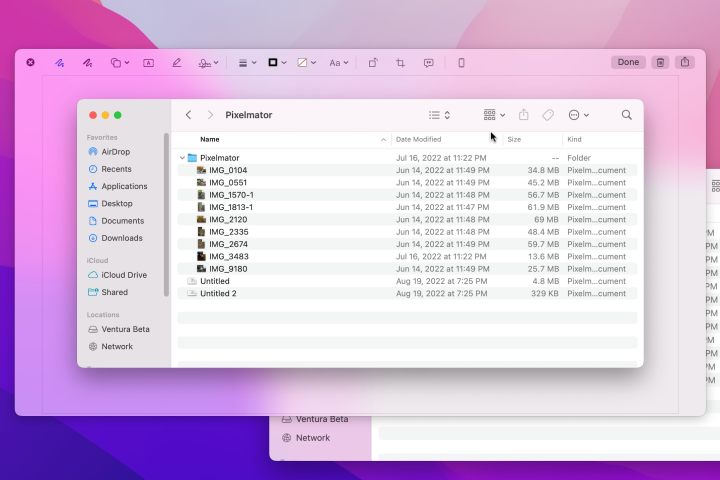Screenshots are a convenient tool, and you can use them to help guide someone through a new app, capture essential messages, and even take incriminating photos of your best friend on WhatsApp. Unfortunately, Apple desktops and laptops don’t come with a straightforward Print Screen key.
Thankfully, MacOS has plenty of keyboard shortcuts and a couple of apps that allow you to get the shot you need just as easily. There are plenty of options and customizations. Here’s everything you could ever want to know about taking a screenshot on your Mac.
Using keyboard shortcuts
MacOS keyboard shortcuts are the quickest ways to take screenshots, whether you’re capturing the entire screen or just a portion. By default, Apple’s methods save your screenshot to the desktop, but if you want to copy the screenshot to the clipboard, there’s a keyboard shortcut you can use instead.
Capture the entire screen
Accoring to the Official Apple website, Press the Command + Shift + 3 keys simultaneously for instant capture of your desktop.
A screenshot preview appears in the bottom-right corner of your screen, giving you quick access to editing tools.

Capture a selected area
Press the Command + Shift + 4 keys simultaneously. With your pointer now turned into a crosshair, click and drag to draw a box around the region you want to be captured. When you let go of the mouse button, the screenshot saves to your desktop.
Capture a single window
Step 1: Press the Command + Shift + 4 keys simultaneously so that your pointer becomes a crosshair.
Step 2: Press the Spacebar. The pointer changes to a camera icon.
Step 3: Any window you hover over is highlighted with a light blue overlay. Click on the window you want to capture, and the image saves to your desktop.
This method doesn’t just capture windows — you can save the desktop, the menu bar, the dock, or even an open menu by itself.
The image you save consists of the window and its shadow against a transparent background (PNG). If you don’t want the shadow, press and hold the Option key (or Alt) as you click to save the image.
Touch Bar screenshot
Note that if you have a MacBook Pro with a Touch Bar, these options appear on the OLED strip. Another Touch Bar exclusive is taking a screenshot of the Touch Bar display, which can be done by hitting Shift + Command + 6.
Finding the Screenshot app
Keyboard shortcuts work well for programmers, but a point-and-click user interface is easy for everyone to use. That’s why Apple also includes a Screenshot app, and it gives you even more control over screenshots. The app also lets you take screenshots after a five-second or 10-second delay, allowing you time to open a menu or do some other setup that might not be possible with the keyboard shortcut before capturing an image on your display. There are three ways (shown as steps 1 to 3 below) to find the Screenshot app.
Step 1: Open your Mac’s Launchpad and scroll through or type in the search box at the top to locate the Screenshot app, then double-click to open it.

Step 2: You can also hold Command + Spacebar to start a Spotlight Search. Begin typing “Screenshot,” and the app will soon appear in the results. Select Screenshot from the top section of the search results to open the app. If you see Screenshot lower in the results, that will start a web search for “screenshot” as a search term, so make sure to choose a result near the top.

Step 3: Open the Finder by choosing the smiling, blue face icon at the bottom-left of the Dock, then select Applications from the left sidebar. Next, open the Utilities folder, scroll down to find the Screenshot app, and open it.
If you think you’ll use the Screenshot app frequently, you can keep it in the Dock by right-clicking the app icon and selecting Keep in dock from the Options menu.

Using the Screenshot app
The Screenshot app looks like a floating toolbar near the bottom of the screen with buttons that look like the type of screenshot that they capture. At the far left is full-screen capture, then window and partial-screen capture. In the next section, full- and partial-screen recording buttons appear, followed by an Options menu. and a Capture button.
Step 1: Choose one of the screenshot buttons, then Capture to grab a save of what’s on the screen. The Screenshot toolbar won’t be included in the capture.

Step 2: If something needs to be set up, such as a menu opened to show its contents in the screenshot, select the 5 seconds or 10 seconds delay from the Options menu.
You can also pick a different default save location for your screenshots or send screenshots to another app like Mail or Messages.
If you want to see the mouse pointer arrow in the screenshot, enable Show mouse pointer in the Options menu.

Step 3: The Floating Thumbnail option is enabled by default, but when taking multiple screenshots in a row, the thumbnail might be captured in some of the images since it appears on-screen. Switch Floating thumbnail off in the Options menu when you are taking quick screenshots.

How to add annotations
MacOS’ Markup capabilities are built into the Screenshot app. That means you can easily add highlights to text, draw arrows to point out details, make freehand sketches, add your signature, and much more to any screen capture.
Step 1: To see the Markup toolbar, just select the thumbnail that appears in the bottom-right corner after taking a screenshot.

Step 2: After you select the screenshot’s thumbnail, it opens in a window with a Markup toolbar at the top. This is a system utility window that appears above all other windows and lacks the usual maximize, minimize, and sizing options of an app window. There are several drawing tools, a text tool, a signature option that lets you sign on your trackpad or take a photo of an ink and paper signature with a webcam or iPhone, and more.

Step 3: Perfect squares and circles are possible when using the Shapes tool, but the Sketch tool at the top-left is quite helpful at correcting wobbly, hand-drawn shapes, including boxes, stars, triangles, ovals, and arrows.

Step 4: It’s also easy to edit your drawings and annotations. Deselect the current tool so the cursor becomes an arrow and choose any annotation to adjust its size, position, and color. Hit the Delete key to remove that sketch, text, or signature.

Step 5: When you’re satisfied with marking up the screenshot, choose the Done button at the upper right to save the image. You can also use the Share menu to AirDrop and send to another app, or simply trash the screenshot if you’ve decided you don’t want it.

Screenshot tips and tricks
There are a few tricks that use the Mac keyboard to change how a screenshot works. These tips work no matter whether you started the screenshot with a keyboard shortcut, the Screenshot app, or the Preview app.
Step 1: Press and hold the Control key while capturing a screen grab to copy it to the clipboard instead of saving it as a file. The Option key is quite useful for Mac screenshots as well. Hold Option when you’re taking a screenshot of a window to remove the shadow that will otherwise surround the window in the image.

Step 2: If you hold down Option while changing the dotted outline in a partial screenshot, dragging an edge or corner makes the same movement on the opposite corner or edge. It’s a handy way to keep the center in place while resizing the area of the screen that will be captured.
How to change keyboard shortcuts
It’s really hard to press three or four keys at once when using one hand, and it can be challenging even with two hands. Thankfully, MacOS includes a way for you to customize the keys used for screenshots.
Step 1: Choose the Screenshots section from the left sidebar, then find the shortcut that you want to change and double-click the far right on the shortcut code to highlight it.

Step 2: Press and hold the keyboard combination that you prefer and it will appear in place of the old shortcut.

Using Preview to take a screenshot
Preview is the default tool that allows you to open everything from photos to PDF files (and here’s how to convert them). It has plenty of lesser-known features, such as annotating documents and images by selecting the Markup icon in the upper-right. Preview captures screenshots, too. Here’s how to screenshot on a Mac with Preview.
Step 1: In the Preview app, open the File menu and the Take screenshot submenu, then choose From selection, From window, or From entire screen, depending on your preference.

Step 2: The keyboard shortcut method is far quicker, and the Screenshot app is easier, but Preview lets you name the file before saving it to your preferred location.

Taking and saving Mac screenshots
What happens once you take a screenshot? Assuming you didn’t just send it to the clipboard, your Mac automatically stamps it with the date and time it was taken before saving it as a PNG file on your desktop. This is handy for immediate reference, but your desktop will quickly become a cluttered mess if you’re taking multiple screenshots in a row.
If using the default save location of the Desktop, screenshots will gather in the corner and spread across the display. You can now quickly group them using Stacks — right-click the desktop and select Use stacks — to declutter your viewing area.
MacOS’ built-in Screenshot app can record the screen, as mentioned above, but for more options for screenshots and to annotate screen recordings, check out our favorite screenshot apps on our list of the best MacOS apps. The TinyTake for Mac app is one of our favorites because it allows you to take precise screenshots and manipulate images in great detail.
Terminal hacks provide more options
By using the Terminal app, you can use system commands to change the file format or default name and remove a screenshot’s timestamp. This adjustment might be important for you, but caution should be used when making changes in MacOS’ Terminal since the commands must be typed in exactly. Don’t forget to press Enter after running commands.
Change the file type
defaults write com.apple.screencapture type JPG
Although this example uses JPG, the default is PNG. Other options include TIFF, GIF, and PDF. Be sure to include a space between “type” and the format you want.
Change the default name
defaults write com.apple.screencapture name “NAME”; killall SystemUIServer
Replace NAME with whatever you want to call it.
Remove the timestamp
defaults write com.apple.screencapture “include-date” 0; killall SystemUIServer
Replace the 0 with a 1 to reinstate the timestamps.
Remove drop shadows
defaults write com.apple.screencapture disable-shadow -bool true ; killall SystemUIServer
You can bring shadows back by changing “true” to “false.” You can also disable shadows altogether when saving a screenshot by pressing and holding the Option or Alt key, depending on your device.
Each of these commands may require a reboot to take effect.










